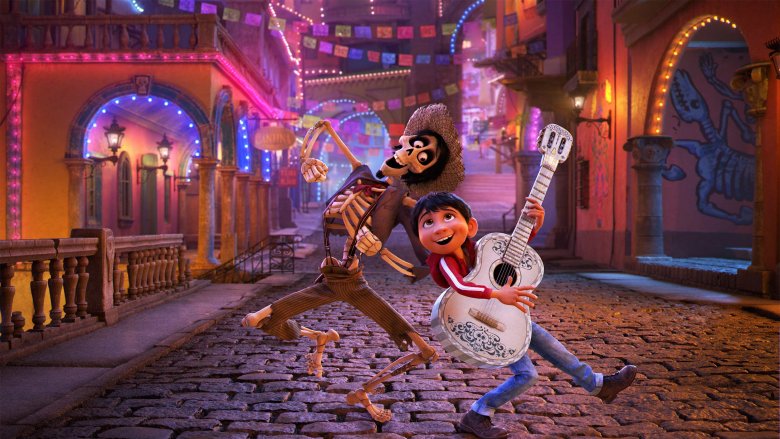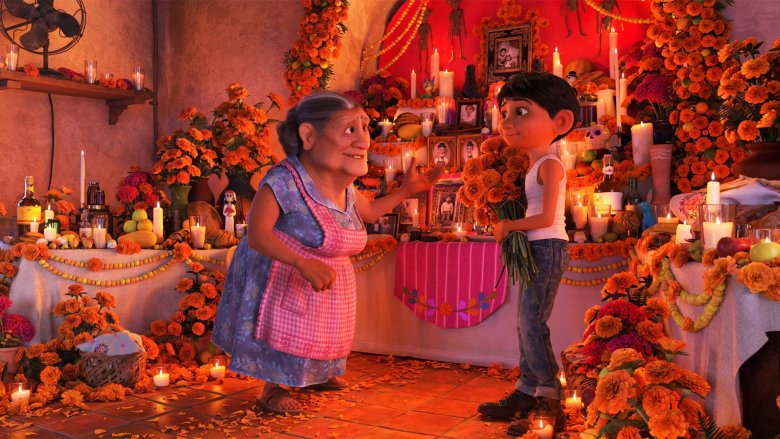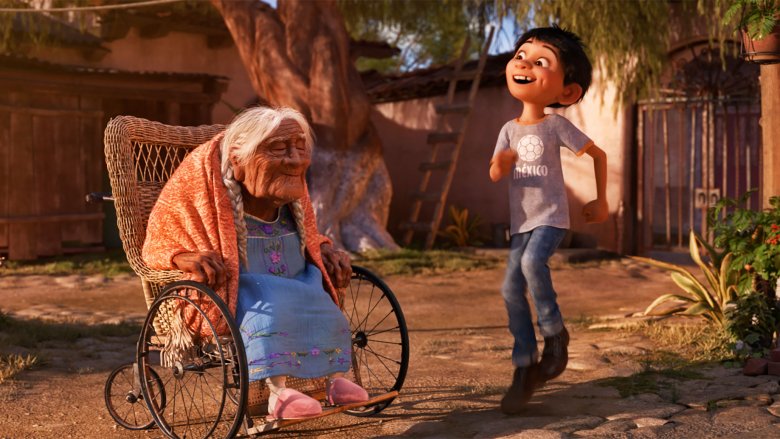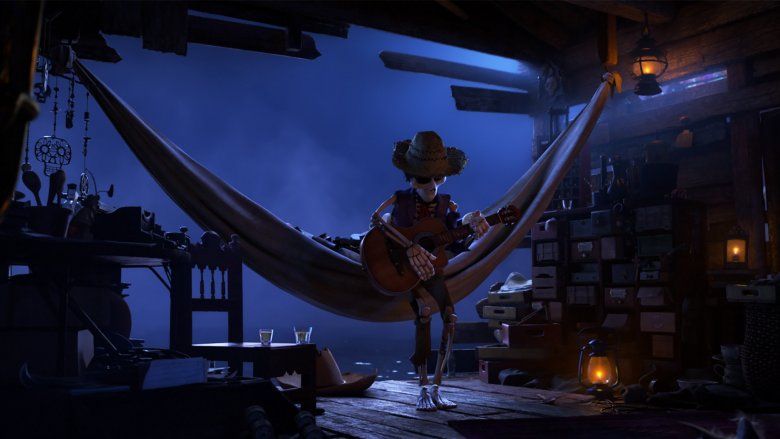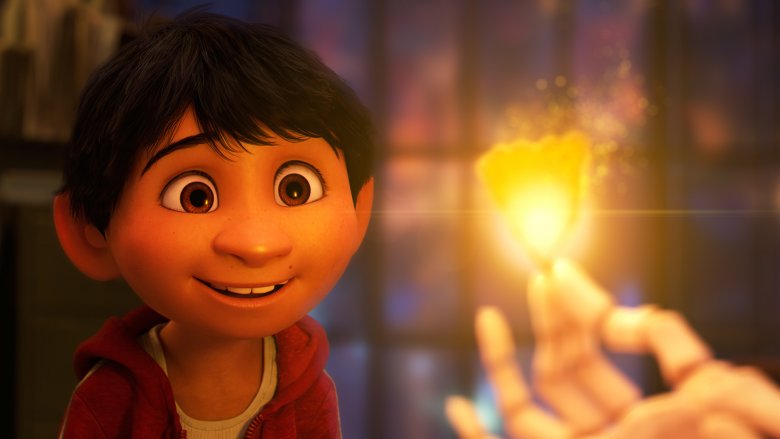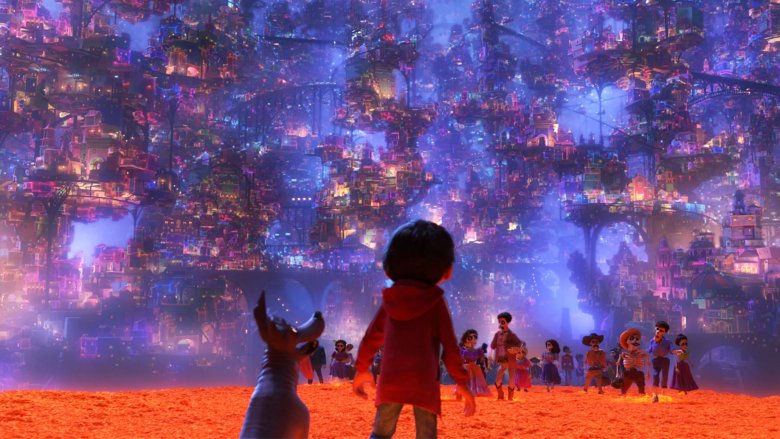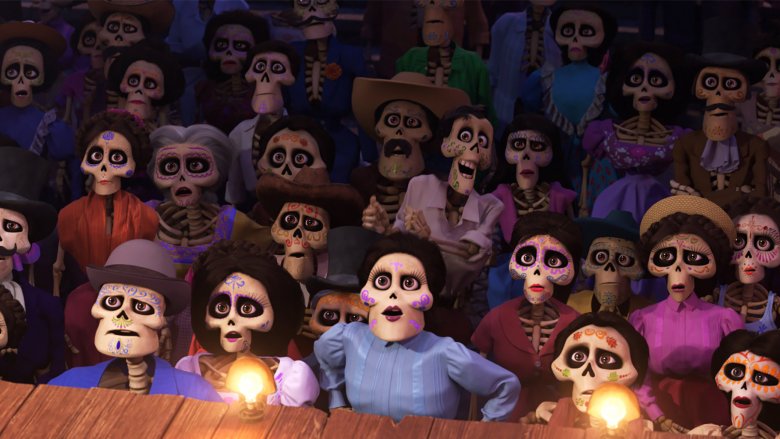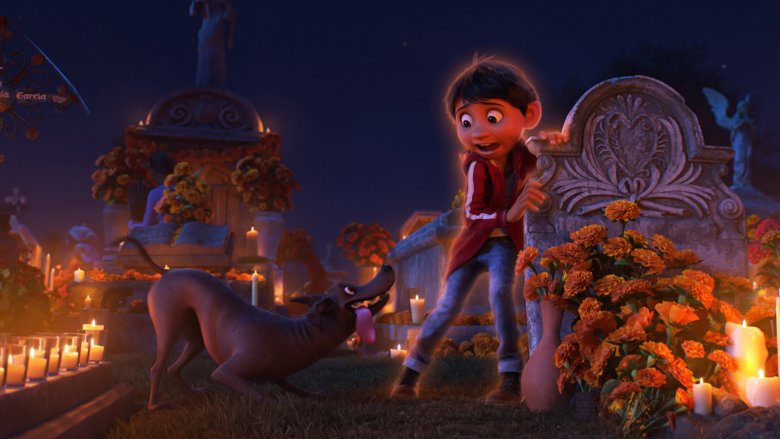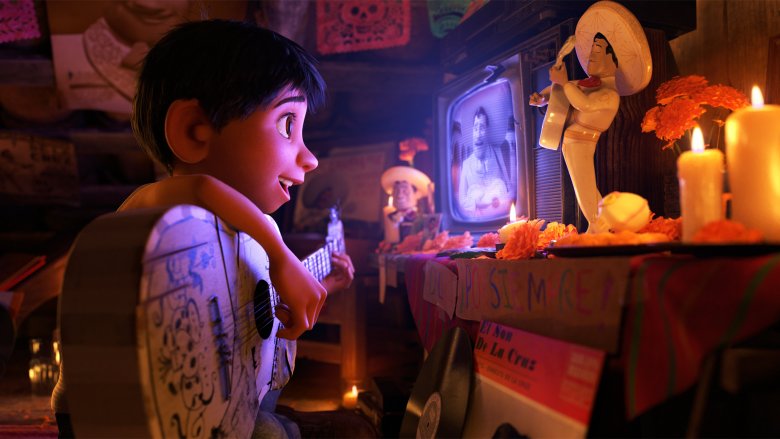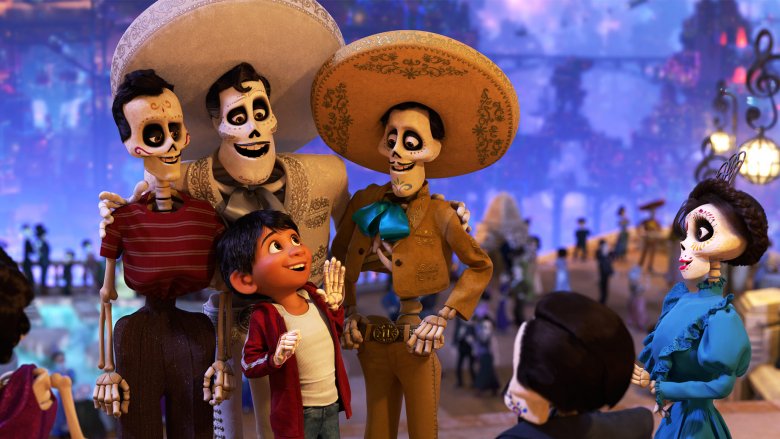The Untold Truth Of Coco
All Pixar movies take a long time to develop, even by Hollywood standards. The studio spends years building their lavishly rendered stories, going back over the story and the characters time and time again until everything is just right. But even for Pixar, the journey Coco took from idea to blockbuster was a rather lengthy one. The film started as nothing more than an ambition to tell a story set around Mexico's Day of the Dead, and passed through several character changes, rewrites, and even a public relations backlash before it finally became a critically acclaimed box office hit. So what took so long, what changed, and how did we arrive at the film we now know and love? From creative consultants to a new co-director and the way the film wound up with its title, this is the untold truth of Coco.
Brought to life by the Day of the Dead
Director Lee Unkrich was fresh off the triumph of Toy Story 3 when the idea for Coco came to him — at Walt Disney World, of all places. According to Unkrich, he was in the middle of a boat ride at Epcot's Mexico pavilion when he saw an image that ignited a spark of inspiration.
"We passed a mariachi skeleton band, and that was my trigger moment," he recalled. "I started to think about the potential of telling a story set against the culture of Mexico. I had never seen a full story told against Dia de los Muertos."
From there, Unkrich pitched the idea to then-head of Pixar John Lasseter, emphasizing the importance of family and music in the story. Lasseter approved the project and Unkrich started moving forward, but Coco was different from other Pixar productions. While most films start with at least a rough sketch of a story, Unkrich started from basically nothing. When Coco entered development, it did so as a film built around Dia de Los Muertos and nothing more.
"When I did Toy Story 3, we settled on a few basic ideas that were going to be part of the film. And of course we had most of our characters already set, and the look of the world," Unkrich said. "In this case, we had nothing. I mean, we just had a blank piece of paper and that was it."
A not-so-temporary title
If you're approaching Coco for the first time, you might spend a good bit of the film a bit confused over the title. Its namesake, Miguel's (Anthony Gonzalez) great-grandmother, is revealed fairly early on, but her significance to the plot is unclear until much later, when Hector (Gael Garcia Bernal) reveals that he — not Ernesto (Benjamin Bratt) — is Miguel's long-lost musician relative, and that Coco is his daughter, the only person still living who remembers him. At that point, the name takes on a great emotional weight, but for much of the production process it was used only as a placeholder — a working title for the filmmakers until they came up with a better one.
"We didn't know what we were going to call the film for a very long time," Unkrich said. "We made lists of hundreds of different titles to try and figure out what it could be. Coco was always just kind of a code name."
Over time, as the film took shape, "Coco" took on more and more meaning, and even though it takes a while for the film to explain its name, Unkrich and company stuck with it.
'Final death' looms
Because Coco began as nothing but a concept, much of what became important in the final film grew out of the development process. After getting the green light to pursue his idea, Unkrich and the production team began a thorough research process in an attempt to absorb every detail about the Day of the Dead. It was then that they came across the idea of "final death" — the notion that you die in the mortal world, and die again in the afterlife when your memory in the land of the living is finally extinguished.
In the film, this idea of "final death" drives much of the story. It's Hector's motivation for helping Miguel and then ultimately revealing his true identity, and it's the reason the film is called Coco, because Coco is the last person in the land of the living who remembers Hector. According to Unkrich, though, this film-defining idea was initially just a small part of the story.
"At the time [we learned about it], we thought it was a poignant idea and it was something we wanted in the movie," he recalled. "But after some time we came to the realization that no, that's the idea of the movie which needed to permeate everything in the film."
Coco the All-American?
Another key element of the film that evolved in the development of Coco was its protagonist — who wasn't always going to be Miguel. While the final version is populated entirely by Mexican characters and steeped in Mexican culture, the original story involved an American boy with a Mexican mother and an American father. After his mother died, the boy's father would take him down to Mexico to meet her side of the family, where he'd learn about Dia de los Muertos and go on an adventure. Unkrich realized fairly early on that this simply wouldn't work, particularly when he considered what the holiday really represents.
"It was ultimately a story about a kid dealing with his grief and learning to say goodbye to the memory of his mother," Unkrich said. "And I realized we were telling a story that was thematically completely antithetical to what Dia de los Muertos is about. Die de los Muertos is about never letting go."
This concern, plus concern over trying to tell a Mexican story from an American perspective, led Unkrich and the team to realize they were "making a mistake." They scrapped the American boy, and Miguel was eventually born.
Inspired by a real Mexican city
Early on in the production, Unkrich knew that he and his team would have to immerse themselves in Mexican culture if they wanted the film to look and feel authentic, so research trips to Mexico were scheduled. While there, the team came up with several key visual inspirations, and production designer Harley Jessup was particularly taken with the city of Guanajuato.
"It's a city of terraced architecture that is going up steep hillsides — very brightly colored and layered," he recalled.
Jessup used Guanajuato as his inspiration for the Land of the Dead in the film, which is presented as a city full of layered towers that go up higher and higher as each layer of the history of Mexico is added to them by the deceased.
"At the bottom of each tower are the Aztec and Mayan pyramids," said Jessup. "Above that, Spanish colonial period buildings; above that are Mexican Revolution era and Victorian era buildings; and then into the 20th century and modern day."
A public backlash
Though Coco is very heavily rooted in Mexican culture, it began as the brainchild of a white director who had a deep desire to not only tell his story, but to ensure its authenticity. Those efforts took a turn toward PR nightmare in 2013, when Disney attempted to trademark the phrase "Dia de los Muertos." For Disney from a corporate standpoint, it was an attempt to establish some kind of marketing foothold on a film that didn't yet have an official title. Prominent Latinos saw it as a cold attempt by an American corporation to appropriate a cornerstone of Mexican culture, and they were outspoken in their criticism.
The backlash prompted Pixar to relax its usually rather secretive production process and hire several Latino "cultural consultants" to work on the film, including cartoonist Lalo Alcaraz, playwright Octavio Solis, and Mexican Heritage Corp. president Marcela Davison Aviles.
"Pixar was already on its way to making this a culturally authentic film, and we met somewhere in the middle," Alcaraz said. "And even though I'm not very corporate, they listened to what I had to say."
The consultants provided input on every phase of the production process, from character designs all the way through to test screenings.
A co-director's journey
Cultural consultants from outside Pixar weren't the only ways in which the project was enhanced by creative Latino influence. One key player also came from within the production, rising through the ranks to become one of Coco's most important voices. Molina, who is Mexican-American, had previously worked for Unkrich as a storyboard artist on Toy Story 3; eager to be a part of Coco, he signed on as a story artist. It quickly became clear that Molina could do more. When Unkrich struggled with the script, Molina wrote his own pages on spec and submitted them to the director in an attempt to lend a hand.
"I submitted them, but I did it very respectfully," he recalled. "I said, 'I don't know if these are helpful to you, but I just need to get them out of my system.' But the more time we spent of the story, the more time we spent talking about what the film could be, the more we realized we were on the same page." Molina was promoted to co-writer and, eventually, co-director of Coco.
Secrets of the shrine
One of the most important moments in the film comes when Miguel retreats into a little hideaway he's built for himself where he can secretly indulge in his true musical passions. The tiny room functions as a miniature shrine to his musical idol Ernesto de la Cruz, featuring photos and albums, Miguel's own battered guitar, and a small TV where Miguel can play a video compilation he's made of key De la Cruz moments. It's a vital scene because it reveals just how serious Miguel is about music, and it came from a variety of influences. The Coco team viewed other movies about young people trying to chase a dream in defiance of their families, including Whale Rider and Billy Elliot, but the clearest inspiration may have come from co-director Adrian Molina's own childhood dreams of being an animator.
"I remembered that I had seen episodes of the 'The Wonderful World of Color' on the Disney Channel, episodes from way back, and you would see little snippets of how they would do animation," Molina recalled. "These episodes would rerun at 4 a.m., and I remember waking up every morning, sticking in a videocassette, and crossing my fingers that it would record one of the episodes where they would talk about how a film was animated."
Like Miguel, Molina cherished every snippet of his heroes he could scrape together, and that made its way into the movie.
Skeletal software advancements
Pixar will forever have the distinction of producing the first entirely computer-animated feature film in Toy Story, but while that technology is commonplace now, each film the studio creates is a new challenge, and an opportunity for a potential new first in the field. It happened with the fur in Monsters Inc., the water in Finding Nemo, and Merida's hair in Brave — and it happened again with Coco when Pixar realized it would need to animate dozens of living skeletons.
The skeletons presented several challenges. For one thing, they had to actually fit the vibe of a family-friendly film. For another, they had to actually look like skeletons, which meant the animators could only cheat a little when tweaking the anatomy (for example, they still have eyeballs). Most importantly, the skeletons had to wear clothes, walk around, dance, and be just as expressive as the living human characters in the movie, which became a problem when animators realized their software wasn't up to the task. When clothing was placed on the skeletons in the old program, it didn't react properly, and would get pinched and tangled between bones.
As a result, Pixar spent three years revamping its software to accommodate the film, specifically focusing on the "collisions system" which depicts how animated objects interact. By the time they were done, the skeletons didn't just wear clothes, but they wore them tight against their ribs — just like real walking, talking skeletons might.
